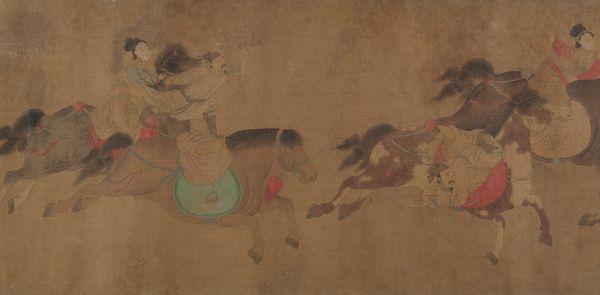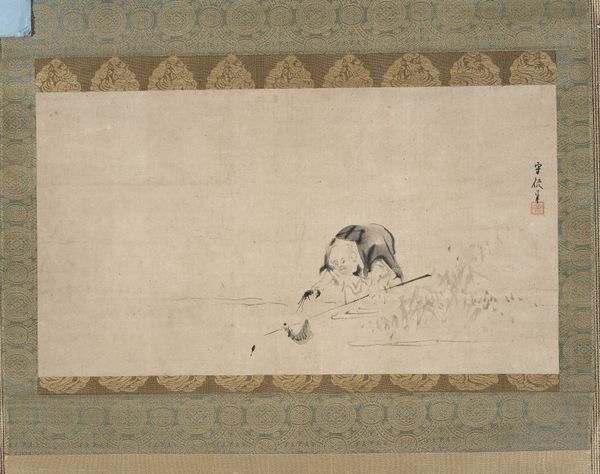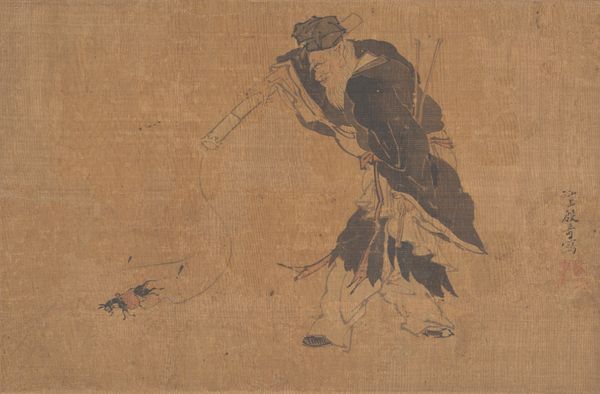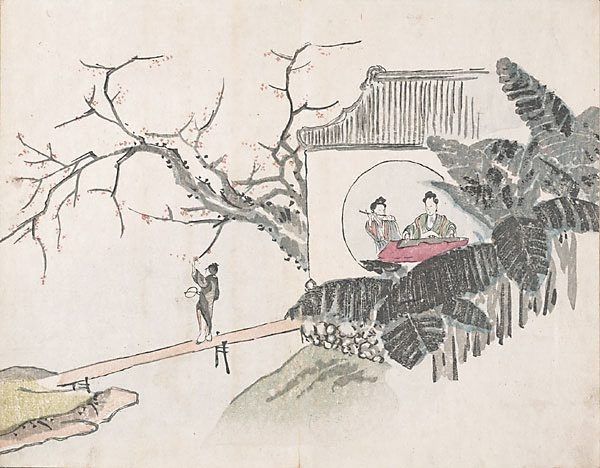
paper, watercolor, ink
#
water colours
#
narrative-art
#
asian-art
#
ukiyo-e
#
paper
#
watercolor
#
ink
#
genre-painting
#
watercolor
Dimensions: 10 3/8 × 43 1/2 in. (26.4 × 110.5 cm) (image)49 1/4 × 50 7/8 in. (125.1 × 129.2 cm) (mount)
Copyright: Public Domain
Curator: What strikes me immediately about this piece is the sheer unexpectedness of it! It has a playful, almost absurd quality. Editor: I agree. The artist, Ogawa Haritsu, also known as Korin, created this watercolor and ink work on paper around 1738. It is entitled “Frogs in Writing Contest." Curator: "Writing contest!" How wonderful. It subverts all the seriousness we often ascribe to the traditionally powerful figures depicted in art of this period. To see it applied to frogs is just brilliantly satirical. What does its materiality say to you? Editor: It speaks of deliberate creation. I'm drawn to the watercolor's delicate touch. You know, Haritsu wasn't just painting frogs; he was likely grinding his own inks and carefully preparing the paper itself. It underlines a real connection between the artist’s hand and the final image. And the narrative implies how specialized labor trickles down. Curator: The composition guides your eye cleverly through the scene, too. Note how the seated frogs, dressed as scholars and officials, occupy a central space. This highlights the institutional elements, the roles and customs associated with writing and learning during that time. What sort of critique is he making about the social roles being acted out here? Editor: Maybe he’s playing with ideas of hierarchy, pointing to who gets to participate in these ‘high-minded’ cultural activities and who doesn't. Are the frogs a symbol, mocking someone specific perhaps? Were all echelons of Edo society obsessed with poetry contests and writing? Curator: Or more universally, is he inviting us to consider the absurdity of formal contests and rigid societal roles themselves, regardless of the participants? Are frogs inherently less deserving of such roles, or is it simply the spectacle of it that’s humorous? It’s really making me consider how different art practices could create different kinds of meaning within the society, no? Editor: Right! It really challenges how we consider the role and accessibility of cultural creation and production. Looking at these carefully rendered frogs competing formally to produce poetry and written word allows me to appreciate his artistic skill! Curator: Absolutely, I think, ultimately, Ogawa invites the viewer to consider how cultural authority is performed and perceived, no matter who the players are. Editor: Yes, seeing this level of detail and intent with materiality encourages me to rethink my definitions of labor and fine art.
Comments
minneapolisinstituteofart almost 2 years ago
⋮
Frogs with human characteristics engage in poetry writing in this handscroll mounted as a hanging scroll. While some frogs appear naked, others don courtly attire: a black cylindrical hat and robe for the males, and the layered kimonos and long flowing hair for the females. The dressed frogs appear and act like Japanese aristocrats, recitingpoems written on thin strips of paper. Most of the naked frogs at the left grind ink for the courtiers to use. Meanwhile, a single frog at the right spits out a stream of water toinscribe the standing screen with the first line of a poem, perhaps as a commentary by the artist of how the art of poetry composition had trickled down to the lower classes.This illustrated fragment might have been a part of a narrative scroll, but the textual portion has been lost.
Join the conversation
Join millions of artists and users on Artera today and experience the ultimate creative platform.













